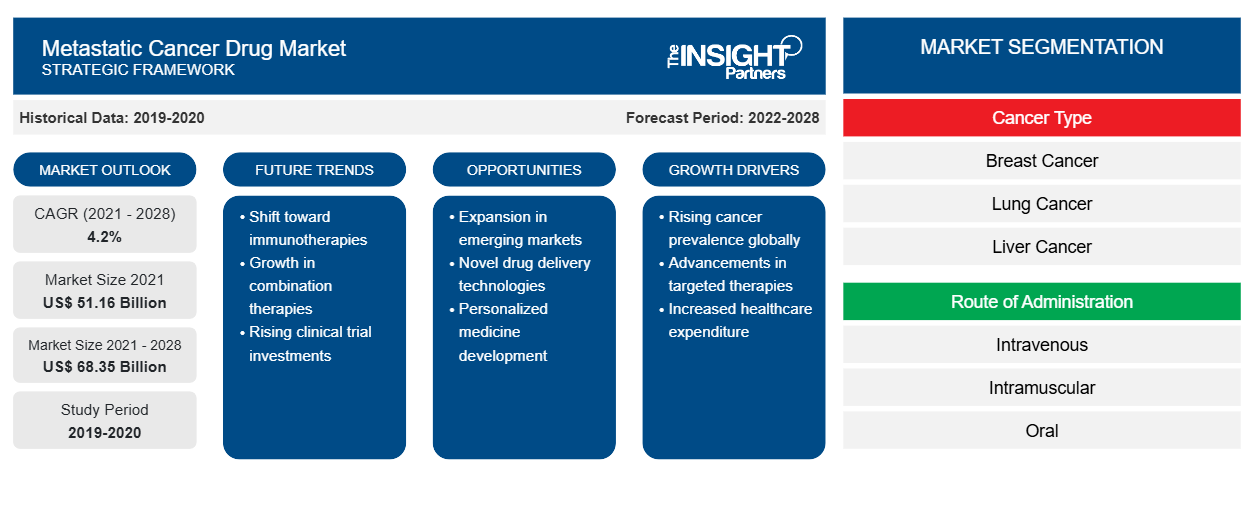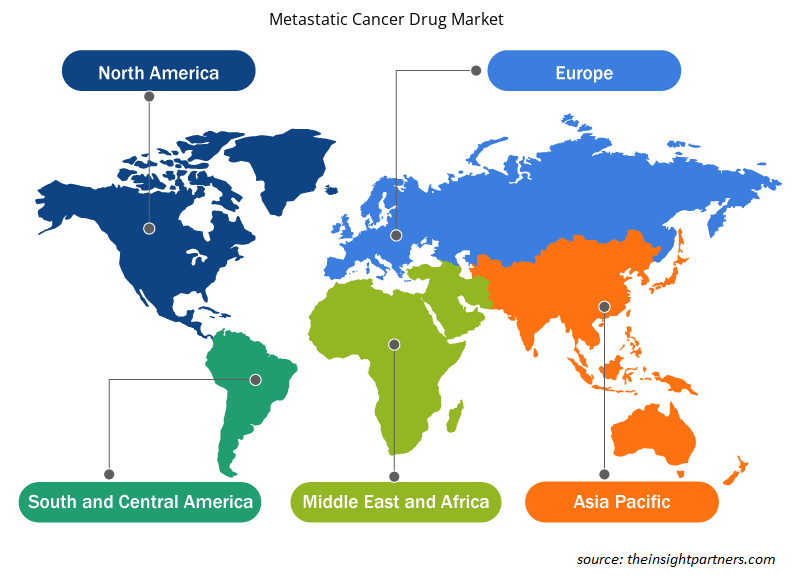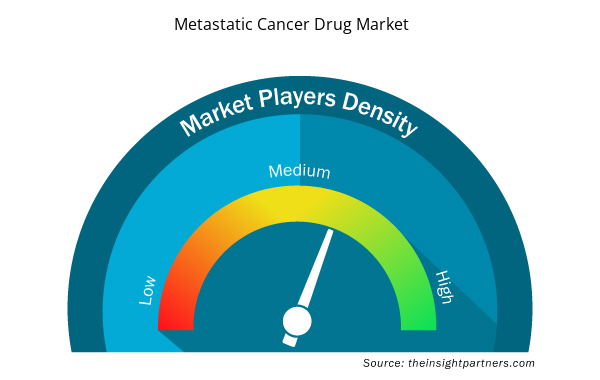[Research Report] The metastatic cancer drug market size is projected to reach US$ 68,349.54 million by 2028 from US$ 51,157.97 million in 2021. It is expected to grow at a CAGR of 4.2% from 2021 to 2028.
Metastatic cancer is defined as an advanced stage cancer that spreads to other body parts, and the drugs used for the treatment of advanced-stage cancer are known as metastatic cancer drugs. These drugs are used via various therapies, such as chemotherapy, immunotherapy, and targeted therapy.
The metastatic cancer drug market is analyzed on the basis of cancer type, route of administration, drug class, product, end user, and geography. The market, by geography, is broadly segmented into North America, Europe, Asia Pacific, the Middle East & Africa, and South & Central America. The report offers insights and in-depth analysis of the market, emphasizing the parameters, such as metastatic cancer drug market size, trends, technological advancements, and market dynamics, along with the analysis of the competitive landscape of the globally leading market players.
Customize This Report To Suit Your Requirement
You will get customization on any report - free of charge - including parts of this report, or country-level analysis, Excel Data pack, as well as avail great offers and discounts for start-ups & universities
Metastatic Cancer Drug Market: Strategic Insights

- Get Top Key Market Trends of this report.This FREE sample will include data analysis, ranging from market trends to estimates and forecasts.
Customize This Report To Suit Your Requirement
You will get customization on any report - free of charge - including parts of this report, or country-level analysis, Excel Data pack, as well as avail great offers and discounts for start-ups & universities
Metastatic Cancer Drug Market: Strategic Insights

- Get Top Key Market Trends of this report.This FREE sample will include data analysis, ranging from market trends to estimates and forecasts.
The metastatic cancer drug market is attributed to the high prevalence of metastatic cancer and government initiatives to support developments in cancer treatment. However, the high cost of oncology drugs restricts the metastatic cancer drug market growth.
Market Insights
High Prevalence of Metastatic Cancer
High Prevalence of Metastatic Cancer
Cancer is one of the health conditions that significantly impact societies worldwide. According to the data provided by the National Institute of Cancer, in 2020, 1,806,590 people were suffering from cancer in the US while 606,520 people died from cancer. According to the American Institute of Cancer Research, in 2020, 18,100 cases were active worldwide. Furthermore, the World Health Organization (WHO) stated that 10,000 deaths, or 1 in 6 deaths globally, were due to cancer. The most common cancer types are lung cancer, breast cancer, colon cancer, rectum cancer, and prostate cancer. The condition develops in 400,000 children every year. Carcinogenic infections—including Helicobacter pylori, hepatitis B virus, human papillomavirus (HPV), hepatitis C virus, and Epstein-Barr virus—caused 13% of cancer cases in 2018, globally. The International Agency for Research on Cancer (IARC) projects that the number of new cancer cases and cancer-related deaths worldwide will grow 1.6–1.7 fold by 2040 to reach 29.5 million and from 16.4 million in 2018. Further, according to the American Society of Clinical Oncology, in 2021, 290,560 people (287,850 women and 2,710 men) in the US were diagnosed with invasive breast cancer. Breast cancer in females has now surpassed lung cancer and is recognized as the most common cancer type worldwide. Approximately, 2,261,419 women were diagnosed with breast cancer in 2020.
Among all the observations recorded about cancer in the US over the past several decades, one statistic has remained unchanged—metastatic cancer accounts for up to 90% of all cancer deaths each year. These numbers have motivated doctors and researchers to find new ways to treat metastasis, which occurs when cancer spreads beyond its point of origin. In the US, 6% of women were diagnosed with metastatic breast cancer in the first diagnosis. Such a rise in the prevalence of metastatic cancer is driving the metastatic cancer drug market growth.
In North America, Canada is expected to witness considerable growth over the forecast period. The main immunotherapy drugs used in Canada are ipilimumab (Yervoy), pembrolizumab (Keytruda), nivolumab (Opdivo), durvalumab (Imfinzi) and atezolizumab (Tecentriq). However, there are other checkpoint inhibitors poised to bring the overall market growth.
Cancer Type-Based Insights
Based on cancer type, the metastatic cancer drug market is segmented into breast cancer, lung cancer, liver cancer, hematological cancer, brain cancer, prostate cancer, pancreatic cancer, and others. The breast cancer segment accounted for the largest market share in 2021 and is anticipated to register the highest CAGR during the forecast period.
Route of Administration-Based Insights
Based on route of administration, the metastatic cancer drug market is segmented into intravenous, intramuscular, oral, and others. The intravenous segment accounted for the largest market share in 2021 and is expected to register the highest CAGR during the forecast period.
Drug Class-Based Insights
Based on drug class, the metastatic cancer drug market is segmented into HER2 inhibitors, immune checkpoint inhibitors, PARP inhibitors, kinase inhibitors, and others. The PARP inhibitors segment accounted for the largest market share in 2021. However, the HER2 inhibitors segment is expected to register the highest CAGR during the forecast period.
Metastatic Cancer Drug Market Regional Insights
Metastatic Cancer Drug Market Regional Insights
The regional trends and factors influencing the Metastatic Cancer Drug Market throughout the forecast period have been thoroughly explained by the analysts at Insight Partners. This section also discusses Metastatic Cancer Drug Market segments and geography across North America, Europe, Asia Pacific, Middle East and Africa, and South and Central America.

- Get the Regional Specific Data for Metastatic Cancer Drug Market
Metastatic Cancer Drug Market Report Scope
| Report Attribute | Details |
|---|---|
| Market size in 2021 | US$ 51.16 Billion |
| Market Size by 2028 | US$ 68.35 Billion |
| Global CAGR (2021 - 2028) | 4.2% |
| Historical Data | 2019-2020 |
| Forecast period | 2022-2028 |
| Segments Covered |
By Cancer Type
|
| Regions and Countries Covered | North America
|
| Market leaders and key company profiles |
Metastatic Cancer Drug Market Players Density: Understanding Its Impact on Business Dynamics
The Metastatic Cancer Drug Market market is growing rapidly, driven by increasing end-user demand due to factors such as evolving consumer preferences, technological advancements, and greater awareness of the product's benefits. As demand rises, businesses are expanding their offerings, innovating to meet consumer needs, and capitalizing on emerging trends, which further fuels market growth.
Market players density refers to the distribution of firms or companies operating within a particular market or industry. It indicates how many competitors (market players) are present in a given market space relative to its size or total market value.
Major Companies operating in the Metastatic Cancer Drug Market are:
- AbbVie Inc.
- Amgen Inc.
- Bristol-Myers Squibb Company
- F. HOFFMANN-LA ROCHE LTD.
- Novartis AG
Disclaimer: The companies listed above are not ranked in any particular order.

- Get the Metastatic Cancer Drug Market top key players overview
Product-Based Insights
Based on product, the metastatic cancer drug market is bifurcated into branded and generics and biosimilars. The branded segment accounted for a larger market share in 2021. However, the generics and biosimilars segment is estimated to register a higher CAGR during the forecast period.
End User-Based Insights
Based on end user, the metastatic cancer drug market is segmented into hospitals, specialty clinics, and others. The hospital segment accounted for the largest share in 2021, whereas the specialty clinic segment is estimated to register the highest CAGR during the forecast period.
Product launches and approvals are among the commonly adopted strategies by companies to expand their global footprints and product portfolios. The metastatic cancer drug market players also focus on the partnership strategy to enlarge their clientele, which, in turn, permits them to maintain their brand name across the world. They aim to flourish their market shares with the development of innovative products.
AbbVie Inc.; Amgen Inc.; Bristol-Myers Squibb Company; F. HOFFMANN-LA ROCHE LTD.; Novartis AG; ASTRAZENECA PLC.; Eli Lilly and Company; MERCK KGaA; and Pfizer Inc. (Arena Pharmaceutical GmbH); and Johnson and Johnson Services, Inc. are the leading companies operating in the metastatic cancer drug market.
- Historical Analysis (2 Years), Base Year, Forecast (7 Years) with CAGR
- PEST and SWOT Analysis
- Market Size Value / Volume - Global, Regional, Country
- Industry and Competitive Landscape
- Excel Dataset



Report Coverage
Revenue forecast, Company Analysis, Industry landscape, Growth factors, and Trends

Segment Covered
Cancer Type, Route of Administration, Drug Class, Product, and End User

Regional Scope
North America, Europe, Asia Pacific, Middle East & Africa, South & Central America

Country Scope
Argentina, Australia, Brazil, Canada, China, France, Germany, India, Italy, Japan, Mexico, Saudi Arabia, South Africa, South Korea, Spain, United Arab Emirates, United Kingdom, United States
Frequently Asked Questions
Cancer that spreads from where it started to a distant part of the body is called metastatic cancer. The process by which cancer cells spread to other parts of the body is called metastasis. Metastatic cancer is an advanced cancer stage that spread to the other body parts and the drugs used for the treatment of advanced stage cancer are known as metastatic cancer drugs. These drugs are used through various therapies such as chemotherapy, immunotherapy, and targeted therapy.
The factors that are driving and restraining factors that will affect the metastatic cancer drugs market in the coming years. The growth of the market is attributed to some key driving factors such as increasing prevalence of cancer and government initiatives to support drug developments for cancer treatment. However, high cost of oncology drugs is likely to hinder the market growth.
The metastatic cancer drug market, by cancer type, is bifurcated into breast cancer, lung cancer, liver cancer, hematological cancer, brain cancer, prostate cancer, pancreatic cancer, and others. The breast cancer segment held the largest share in 2021 and is anticipated to register the highest CAGR during the forecast period.
The metastatic cancer drug market majorly consists of the players such as AbbVie Inc., Amgen Inc., Bristol-Myers Squibb Company, F. HOFFMANN-LA ROCHE LTD., Novartis AG, ASTRAZENECA PLC., Eli Lilly and Company, MERCK KGaA, and Pfizer Inc. (Arena Pharmaceutical GmbH) amongst others.
Trends and growth analysis reports related to Life Sciences : READ MORE..
The List of Companies - Metastatic Cancer Drug Market
- AbbVie Inc.
- Amgen Inc.
- Bristol-Myers Squibb Company
- F. HOFFMANN-LA ROCHE LTD.
- Novartis AG
- ASTRAZENECA PLC.
- Eli Lilly and Company
- MERCK KGaA
- Pfizer Inc. (Arena Pharmaceutical GmbH)

 Get Free Sample For
Get Free Sample For